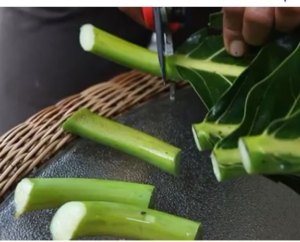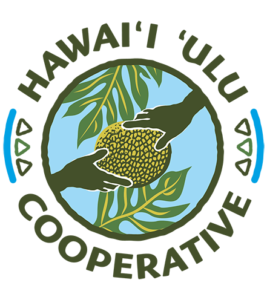Tissue and Soil Testing
Tissue & Soil Sampling Policy for Members
Analyzing tissue and soil samples annually is important to understanding the health of your ʻulu trees and making informed decisions to increase your overall farm productivity. This data also helps inform HUC’s ongoing research in partnership with the University Hawaiʻi on nutrient recommendations for ʻulu! Please read our Tissue & Soil Sampling Policy below for important information on the annual sampling schedule, pricing, and procedures.
- Tissue and soil sampling is limited to two time windows per year: April 1-15 and, if desired, October 1-15. If only sampling once per year, this should be done during the first two weeks of April.
- During each member’s initial farm visit upon joining the co-op, HUC staff provide hands-on training on best practices for sampling soil and leaf tissue for lab testing. If this visit is conducted in either of the two windows above, HUC staff may also collect samples and drop them off at the appropriate collection point.
- Members pay for their own testing and collect their own samples (currently priced at $20/sample but subject to change upon notice from the lab at any time) during the prescribed windows above. Samples may be dropped off at the Honalo or Alae HUC facilities on Hawai’i Island with prior notice. Neighbor island members may drop off samples at your local CTAHR office and should forward results to HUC when received. Note that sampling costs may vary for outer island members – contact your local CTAHR office for more details and to schedule your sample delivery
- HUC covers shipping costs for Hawaiʻi Island members and provides analysis and customized recommendations when results are received from the lab. Recommendations are based on the latest research from the Indigenous Cropping Systems Lab at CTAHR. Submitting your samples for analysis annually not only helps you, but also contributes to improved collective understanding of nutrient management best practices for the ʻulu farming community at large!
Tissue Sampling Procedure
- When collecting tissue samples, it is important to consider the number, age, location, and variety of the trees on your farm. Taking a representative sample will help to provide best results. For example, if you have only 2 trees of the same variety, it is fine to sample only one tree. However, if you have 30 trees and multiple varieties in different locations on your farm, you may consider taking a sample from each variety in the different locations.
- For each tree being sampled, remove the petiole from the third open leaf from the branch tip on 4 branches spaced equally around the mid-canopy area (see photo below) – this provides an accurate representation of the average nutrient levels in your tree.

Petioles separated from the leaves
- Samples should be placed in a paper bag or envelope and labeled with the farm or farmer name, date taken, variety (if known), age (if known), and a descriptive location (e.g. upper orchard). This HUC Sampling Label is provided as an optional template to make labeling easier for farmers. If using this template, simply print out the 8.5×11″ sheet and staple or tape it to the paper bag or envelope; the printed-out template can also be folded in half and used to hold the samples themselves, using tape or staples to shut the top and sides.
- Once samples are collected and packed, place them in a refrigerator or chilled cooler until ready to deliver.
- Samples must be delivered the same day they are obtained from the field. Please coordinate delivery at least 48 hours in advance with HUC membership staff at farmers@eatbreadfruit.com / (808) 289-2330 if you plan to deliver samples to our Alae or Honalo Facilities.
Soil Sampling Procedure
- When collecting soil samples, it is important to consider the range and diversity of sites where you are growing, or plan to plant, breadfruit. In general, aggregate samples (explained below) can be used to obtain a sample representation of a specific area on a farm, or to look at an orchard as a whole. For example, if you have only 1/2-acre with a few ʻulu trees, taking a singe aggregated sample in the area where the ʻulu is growing would be sufficient. However, if you have a 20-acre farm and there are concentrations or divisions of breadfruit trees in specific areas with different soil conditions, taking multiple aggregate samples would yield the greatest benefit for your farm.
- Taking an aggregate sample means combining multiple samples from within a determined area into a single sample submitted to the lab. Farmers should bring a container to the field and take samples from the 4 corners, and the center, of the defined area. Then mix the soil samples together and remove about 2 cups of material into the prepared container.
- To take each sample, scrape away surface grass/roots and place your spade into the soil 6-8 inches vertically down to create a small hole with a vertical wall. Using a hand trowel or spade, remove a 4-6 inch section of the wall making sure to get as much of the vertical profile as possible and add to your container of aggregate samples for each area. Remove any plant debris, roots, or rocks.
- Like with tissue samples, soil samples should be placed in a paper bag or envelope and labeled with the farm or farmer name, date taken, variety (if known), age (if known), and a descriptive location (e.g. upper orchard). Use this HUC Sampling Label as an optional template by printing out the 8.5×11″ sheet and adhering it to the paper bag or envelope; the printed-out template can also be folded in half and used to hold the samples themselves like a large envelope, using tape or staples to shut the top and sides. Once samples are collected and packed, place them in a refrigerator or chilled cooler until ready to deliver.
- Samples must be delivered the same day they are obtained from the field. Please coordinate delivery at least 48 hours in advance with HUC membership staff at farmers@eatbreadfruit.com / (808) 289-2330 if you plan to deliver samples to our Alae or Honalo Facilities.
Current Fertilizer Pricing for Members
HUC members can order and pick up fertilizer at a discounted price from Nutrien Ag Solutions in Hilo. To place an order, call the number below and schedule a pickup at their facility in Hilo or a delivery if ordering a pallet or more at a time.
Phone: (808) 935-7191
Address: 888 Kalanianaole St, Hilo, HI 96720
Organic Options
- Bioflora Organic 6-6-5 + 8%Ca – 50 lb bag: $44.96
KMag Premium – 50 lb bag: $37.73
Conventional Options
- 10-5-20 Conventional Fertilizer – 50 lb bag: $36.50
Dolomite Ag 10 – 50 lb bag: $19.74
To estimate your farm’s nutrient needs, see our handy Fertilizer Replacement Calculator and Dr. Noa Lincoln’s Nutrient Management Guide
More Soil and Tissue Sampling Resources
Farmers draw on both traditional and modern practices to grow food sustainably. In this video, Dr. Noa Lincoln, Professor of Indigenous Crops and Cropping Systems at the University of Hawai‘i at Mānoa, discusses Indigenous techniques and current production recommendations for ‘ulu cultivation, focusing on nutrient demands, fertilization, pruning, and varietal selection. For a video tutorial on tissue sampling procedures, check out the video above at 1:10 minutes.
Understanding Your Tree Needs Through Soil and Tissue Testing
Toward Standardized Leaf Sampling for Foliar Nutrient Analysis in Breadfruit
Read & digest this publication before sampling for leaf tissue analysis: Toward Standardized Leaf Sampling for Foliar Nutrient Analysis in Breadfruit.
When tissue sampling, use petioles harvested from the third fully open leaf down from the branch tip, at 4 evenly spaced intervals around the mid-canopy.
Soil Sampling: Hawaiʻi Farmers Partner with CTAHR
Soil sampling, especially when tracked over time, can help inform what amount of NPK and compost to use. These tests can also let growers know of excessive nutrient levels or deficiencies which can affect the uptake of other nutrients by your plants. Some growers fertilize conventionally, while others focus mainly on organic matter & soil biology – sampling/analysis can give a farmer a clear snapshot of the state of their farm.
Contact UH CTAHR Extension Office to submit soil samples for testing; see the link below for more information on the pricing and procedures to deliver your samples.
